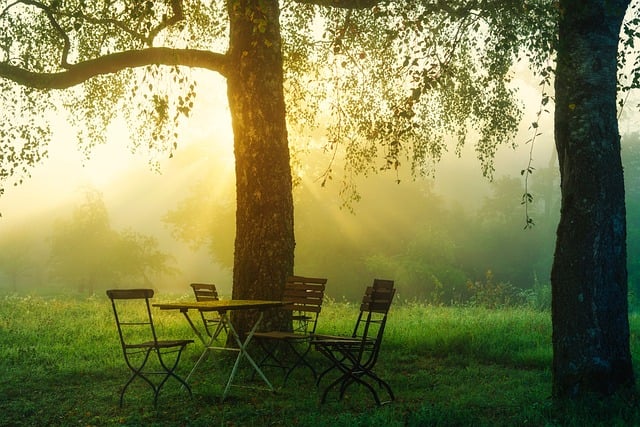How to Design an Energising Garden
Choosing brightly-hued plants and fragrant blossoms may add life to your garden area in the same way that choosing joyful colors for your interiors can make your interiors more uplifting or selecting aromas to wake you up in the morning can brighten your day. We chatted with professionals to learn more about planning an invigorating landscape.
1. Develop a sense of surprise.
A patio including a vine-covered pergola, climbing roses, and a potted lemon tree. Elena Piletra’s vacation apartment has a romantic rose garden. Villa near Lucca, Tuscany, Italy.
(Image credit: Future PLC/Mark Bolton Photography.)
Nothing shouts ‘boring’ like a garden that can be seen all at once; it’s the mystery of not knowing what’s around the corner or on the other side of a flower bed that makes our gardens seem more exciting and dynamic.
‘Make sure you have plenty of surprises – paths, hedges, arches, pergolas, statues, or large pots can add a surprise element to even the smallest space and ensure you don’t experience the garden all at once,’ says Bridget Saunders, co-founder of The Garden House in Brighton, a former derelict market garden that has been restored and now offers garden courses and visits.
‘When we open for the National Garden Scheme, you hear people’s joy at finding a “secret” garden behind a row of terraced homes.’

2. Select an energizing plant palette
Sweet peas sprouting in the garden in large numbers.
Invigorating, feel-good landscapes employ plant colors as a pick-me-up – imagine dopamine-rich colors pouring over your garden borders.
‘Colour is vital for creating an energetic and vibrant landscape. According to plant expert Sarah Raven, the goal is to avoid a hectic licorice all-sorts appearance in which all hues compete for attention.
‘Separating your color palettes to generate distinct moods in your outdoor area may be an effective strategy. A rich family of colors, such as deep brown, copper, and deep purple, provide an earthy but elegant appeal; I often think of them as velvet colors you want to wrap yourself in,’ she adds.
Alternatively, a “boiled sweet” palette of bright and dazzling colors, such as strawberry red, vibrant orange, zingy lemon, and lime, may provide uplifting and stimulating energy. To prevent overdoing it in the garden, stick to complimentary or contrasting colors.
Look at the color wheel to help you pick which colors would look best together in your landscape.
3. Include a lively water feature.
Country fence, fountain, and lawn
A calm and quiet pool, with its reflected surface, may be a conscious component of a wellness garden, encouraging a relaxed mindset. However, if you want a more energizing impression in your garden, consider a water feature concept that incorporates the sound, movement, and glitter of water.
‘One of the more common methods of integrating a whimsical, intriguing element into a garden is to situate a water feature,’ explains Travers Nettleton, proprietor of Garden Art Plus.
‘The interesting combination of light on falling water and a quiet background trickle may fascinate and immerse the viewer while adding a charming element to the garden’s appearance.
You can simply convert an existing pond or still water feature in your landscape using something like the clever solar pond water pump, which costs £79.99 on Very.co.uk.
4. Create a buzz with pollinators.
Bees gather nectar on vivid yellow blooms of Canadian goldenrod (Solidago canadensis) in a sunny summer natural meadow. – Stock Photo
An energizing garden requires a lot of vitality, and not only from plants.
‘A garden teeming with pollinators and animals is energizing and an effective way to bring your area to life. A really energized garden should have a thriving and rich environment, according to Sarah Raven.
‘Gardens with different plant species attract a variety of insects, birds, and other creatures that help with pollination, seed dissemination, and pest management.
‘Bees play a crucial part in a healthy and growing garden, so include lots of pollinator-friendly plants and flowers in your outdoor area. Providing shelter and water can help you build a bee-friendly garden, since bees need lots of water and a safe place to rest.

5. Enhance your mood with scented plants.
A climbing honeysuckle plant against a home.
‘Scent is also a vital aspect in an invigorating garden,’ says Bridget Saunders of The Garden House, which has a variety of aromatic plants in its beds and borders.
When designing a landscape with year-round appeal, remember to include aromatic plants to raise you through the seasons. When developing a fragrant garden, bulbs, blossoms, and lilac blooms will fill the air with perfume in the spring. Roses, sweet peas, and lavender create a fragrant atmosphere throughout the summer. Nicotiana, mint, and Daphne are all autumnal scents. While winter-flowering jasmine and honeysuckle will brighten the chilly months.
6. Bring in birdlife.
A hanging bird feeder built from a teacup and saucer.
There’s nothing like birdsong to energize and revitalize your outdoor environment. But if you want the birds, you’ll have to entice them with a lot of insects.
‘Parent finches and tits need to feed their young protein-rich food, so they’re continually on the lookout for caterpillars, little slugs, snails, and aphids of all shapes and sizes,’ explains Sarah Raven.
‘Insect patches in the corner of a garden are fantastic; use a few pots in a sunny place to create a wildlife sanctuary where birds can easily find food.’
Consider creating a bug motel to attract insects. Alternatively, you may purchase an RSPB-approved bird feeder to attract birds to your outside area.
7. Promote variety within your plan.
A lovely cottage yard, with furnishings and a dog on the grass.
A great room layout features focal pieces that draw our attention, such as a clever combination of colorful cushions, a well-curated exhibit, a prominent vase, or a conversation starter feature wall. Our gardens are no different. They need a variety of features, a color palette, focus points to draw the attention, and plants in all sizes, colors, and forms.
Bridget Saunders of The Garden House feels that gardens should be as diversified as possible in terms of the plants they cultivate. ‘We strive to plant as many different species as possible since it attracts a diverse range of pollinators. We also encourage the use of reused materials, which consistently receives positive feedback from visitors and provides an exuberant show in the garden.
8. Add power pops using pots.
A great display of tulips in a planter.
We’ve all experienced the dopamine rush that comes with donning a bright garment or having the ideal pink couch in our living rooms. We may enjoy the same energizing boost of enthusiasm in our gardens, too.
‘I adore the impression that a single plant in numerous containers has,’ says Sarah Raven. Placing the pots in a prominent spot adds energy to otherwise drab surroundings. This works best when you choose a conspicuous shape, like the lipstick-red tulip Pretty Woman.
Try these ideas and construct your own energizing garden to improve your attitude and vigor every time you walk outside your back door.
How do you enhance a garden?
There are several considerations when decorating a garden, particularly if it contains both food and non-edible plants. Some of the most crucial are pruning, trimming, spacing, companion planting, the potential requirement for raised beds and containers, and regular watering.
What is the foundational pattern in landscape design?
Garden design components and basic patterns.
Grid lines created at 45 degrees may be used to plan the garden. Rectangular themes are the most popular and commonly used. They are altered to give the garden a more formal appearance. This theme allows you to effortlessly split long or narrow gardens into even parts.
What is a quiet garden called?
A Zen garden, also known as a peace garden, is one of the most beautiful outdoor settings to design and enjoy. Creating a sensory experience that enables visitors to actually feel and connect with nature requires the careful selection and arrangement of trees, shrubs, grasses, blooming plants, and accessories.
How do you create a romantic garden?
The charming garden appeals to all five senses. A patch of aromatic rosemary or lavender, a trio of gardenias, or an antique rose trellis all prepare the senses for the richness of the garden’s offerings. Make careful to choose a particular smell to identify its region in the garden.
How do you arrange plants in a garden?
There are two essential guidelines for placing plants in beds: 1) Space the individual plants so that they contact each other when they reach maturity, and 2) overlap and link the masses of plants so that they flow without interruption. Avoid gaps or wide open spaces between masses.

